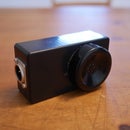Introduction: Balanced Microphone From an Old Telephone
It's been done before, but here is my take on converting an old rotary telephone carbon microphone into a lo-fi mic. I wanted something that I could hopefully use on stage so I wanted to make it balanced. I also wanted it battery powered as opposed to phantom powered on the chance that my DIY job fried someones mixer.
I didn't really invent anything here, just combed the internet.
1. I got some great resources from groupdiy.com a www.diystompboxes.com and found a circuit I liked. I used on a circuit by PRR (post here). The only difference was that I a) added a transformer (see point #2), b) used different resistor value (see point 3) and c) added a 2k resistor after the transformer (it really helped to reduce hiss). I also wanted to try this one on groupdiy by abbey road d enfer (post here), but didn't in the end. If you have, how did it sound?
2. After that I added an audio transformer to convert my signal to a balanced single as described in RaneNote 110 (http://www.rane.com/note110.html)
3.I bread boarded the circuit to tweak resistors and get the best sound I could from the mic. I found this step crucial as the resistor valves affected how much hiss / noise floor I had.
4. I put it together and hacked a mic clip to fit my enclosure
Sound samples at the bottom from this mic. It's all voice (in one case a little banjo), with some delay/reverb.
Parts
-Old phone (rotary / vintage). Needs to have an old carbon mic for the sound (free if you're lucky, $5 to $20 flea market, used, etc)
-resistors (I used 1 x 600 ohm, 1 x 120 ohm, 1 x 2000 ohm). Something close, but really doesn't matter too much (< $1)
-capacitor (I used 10 uF) (< $1)
-600 ohm 1:1 audio transformer ($3 ebay + shipping)
-XLR jack ($6, local supply store)
-on off switch ($5)
-LED (optional) ($1)
-some sort of case ($8, I used a hammond 1591 case)
I was lucky and able to get most stuff free or use spare parts. My build cost was $20, but I only had to buy the case, transformer and XLR Jack.
Quick Update: I made a mic using the speaker part of the phone. It's here if you're interested.
I didn't really invent anything here, just combed the internet.
1. I got some great resources from groupdiy.com a www.diystompboxes.com and found a circuit I liked. I used on a circuit by PRR (post here). The only difference was that I a) added a transformer (see point #2), b) used different resistor value (see point 3) and c) added a 2k resistor after the transformer (it really helped to reduce hiss). I also wanted to try this one on groupdiy by abbey road d enfer (post here), but didn't in the end. If you have, how did it sound?
2. After that I added an audio transformer to convert my signal to a balanced single as described in RaneNote 110 (http://www.rane.com/note110.html)
3.I bread boarded the circuit to tweak resistors and get the best sound I could from the mic. I found this step crucial as the resistor valves affected how much hiss / noise floor I had.
4. I put it together and hacked a mic clip to fit my enclosure
Sound samples at the bottom from this mic. It's all voice (in one case a little banjo), with some delay/reverb.
Parts
-Old phone (rotary / vintage). Needs to have an old carbon mic for the sound (free if you're lucky, $5 to $20 flea market, used, etc)
-resistors (I used 1 x 600 ohm, 1 x 120 ohm, 1 x 2000 ohm). Something close, but really doesn't matter too much (< $1)
-capacitor (I used 10 uF) (< $1)
-600 ohm 1:1 audio transformer ($3 ebay + shipping)
-XLR jack ($6, local supply store)
-on off switch ($5)
-LED (optional) ($1)
-some sort of case ($8, I used a hammond 1591 case)
I was lucky and able to get most stuff free or use spare parts. My build cost was $20, but I only had to buy the case, transformer and XLR Jack.
Quick Update: I made a mic using the speaker part of the phone. It's here if you're interested.
Step 1: The Schematic
Here is the final circuit I used. Not shown on the circuit are the a) LED -- green high efficiency with a 3k or 3.5k resistor (can't remember which I used) and b) a switch to cut power when the mic isn't in use.
The LED resistor was picked to minimize current. The mic didn't draw much and I didn't like the resistor being 50% of the power use!
With my resistors shown and a 9V power source, the mic draws around 6 mA when idle and up to around 8 mA when singing into it. The LED was another 2.5 mA.
R1=600 ohm (ok ok, in reality it was 2 x 270 ohm resistors, what I had in my drawer)
R2=120 ohm
R3=2k ohm. Not necessary but for me it quieted hiss and was worth it. Too much and if affected the sound and output.
C1=10 uF electrolytic (what I had in my drawer).
The transformer was an audio 600 ohm : 600 ohm from ebay ($3). Mine was centre tapped but I didn't use them,
The LED resistor was picked to minimize current. The mic didn't draw much and I didn't like the resistor being 50% of the power use!
With my resistors shown and a 9V power source, the mic draws around 6 mA when idle and up to around 8 mA when singing into it. The LED was another 2.5 mA.
R1=600 ohm (ok ok, in reality it was 2 x 270 ohm resistors, what I had in my drawer)
R2=120 ohm
R3=2k ohm. Not necessary but for me it quieted hiss and was worth it. Too much and if affected the sound and output.
C1=10 uF electrolytic (what I had in my drawer).
The transformer was an audio 600 ohm : 600 ohm from ebay ($3). Mine was centre tapped but I didn't use them,
Step 2: Breadboard Time
For me this step was really important. I set it all up and played with resistors until found the optimal values (very rough use of the word!). In reality most values worked, some just better than others. I tried R1 from 1k to 10k, and R2 to 10k to 100k (roughly). Compared to R1=600 ohm and R2=120 ohm, they had much higher hiss and didn't sound good.
I also tried R1=300 ohm, and it had higher hiss than R1=600 ohm. So for me, R1 was roughly 600 ohm for my mic to sound it's "best". Remember this is a lo-fi mic for effects, not for crystal clear vocals.
I didn't vary C1, but should have. I'll always wonder if C1 as 20 or 50 uF would have been better.
I also tried R1=300 ohm, and it had higher hiss than R1=600 ohm. So for me, R1 was roughly 600 ohm for my mic to sound it's "best". Remember this is a lo-fi mic for effects, not for crystal clear vocals.
I didn't vary C1, but should have. I'll always wonder if C1 as 20 or 50 uF would have been better.
Step 3: Case Work
I wanted to keep everything self contained, so I hacked the phone apart and fit it all into a Hammond 1591 case with the brass inserts for the screws. The brass was important since the 9V battery will need replacing (every 10-15 hours of use based on my current draw).
1. I cut the original phone handle but kept the end intact. The mic cartridge fit nicely into the handle and it made sense to re-use the threads / mouth piece.
2. I used a hole saw bit very slightly larger than the threaded portion of the original handset. The threads first through the hole, and the mouth piece could thread on from the opposite side.
3. The original handset (now just the very end) was trimmed using a coping saw. There wasn't much room left in the case and this is where I had to put the battery in the end
4. A circuit was made on strip board and crammed in, along with LED, switch, XLR jack and mic clip.
5. The mic clip was the female threaded part from normal mic clip with a bolt and washers. The photo explains it better.
6. Everything is bolted on and closed up.
1. I cut the original phone handle but kept the end intact. The mic cartridge fit nicely into the handle and it made sense to re-use the threads / mouth piece.
2. I used a hole saw bit very slightly larger than the threaded portion of the original handset. The threads first through the hole, and the mouth piece could thread on from the opposite side.
3. The original handset (now just the very end) was trimmed using a coping saw. There wasn't much room left in the case and this is where I had to put the battery in the end
4. A circuit was made on strip board and crammed in, along with LED, switch, XLR jack and mic clip.
5. The mic clip was the female threaded part from normal mic clip with a bolt and washers. The photo explains it better.
6. Everything is bolted on and closed up.
Step 4: Fitting It Together
After the case was done, I got the electronics inside, closed it up and rocked out. I'm super happy with it. See step 1 for some sound samples using this mic.







